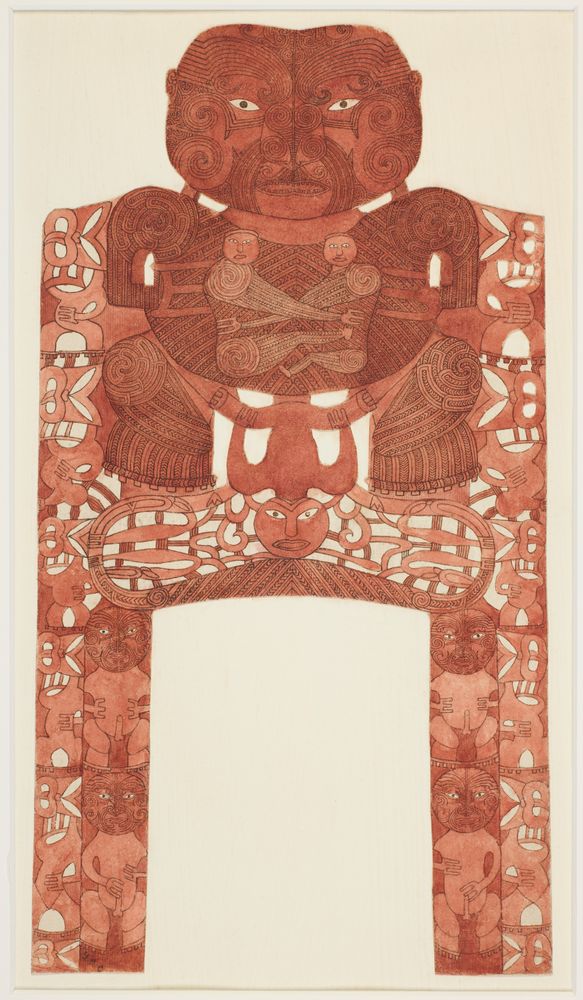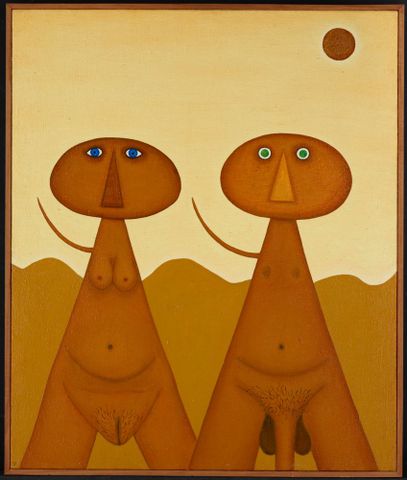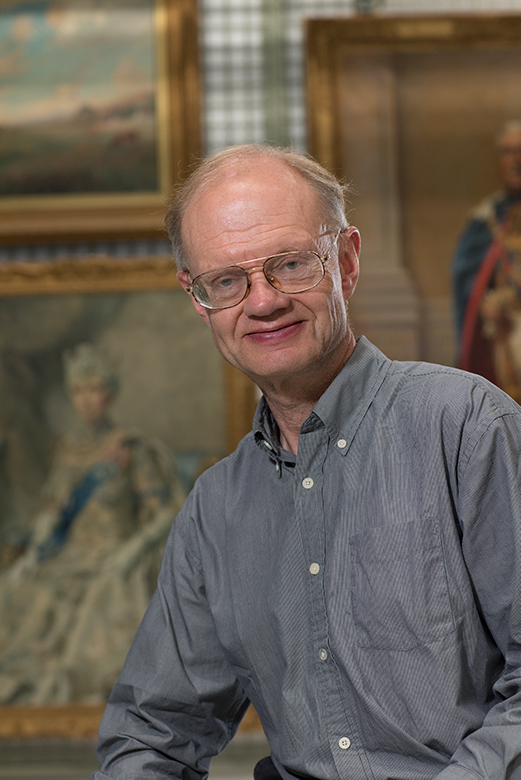
It is
perhaps unavoidable in any broad survey of the history of
artistic development to reconsider the value of a few
well-worn sayings. “There's no accounting for taste” and
“beauty is in the eye of the beholder” may spring
immediately to mind, but clichés only become truisms when
they are based upon generally acknowledged facts. The very
definition of fashion involves a constantly mutating
dialectical process of metamorphosis into “something new
and strange.” To disinterested observers of New Zealand
art it sometimes feels like we are witnessing a continual
game of catch-up, and given our geographical isolation this
is hardly unexpected. What is surprising, however, is the
consistent quality and quantity of the domestic art that
Kiwis have created in the past, albeit in a belated reaction
to broader international developments.
Ample evidence to support such an opinion is provided in a recent published authoritative overview of Te Papa's art holdings. In October, the museum celebrated its new Toi Art display with a magnificent companion piece to its amuse-bouche sampling, Ten x Ten: Art at Te Papa. Entitled simply New Zealand Art at Te Papa, it adopts the same approach of providing an opportunity for different curators to select some of their favourite pieces from the national collection, accompanied by informative summaries of why they are of particular historical interest or possess special cultural value. The difference with this much more comprehensive volume is largely a matter of ambition, scale, and dimension. It is no mere dégustation, but rather an entirely satisfying entrée, allowing the general reader to appreciate the astonishing range of Te Papa's art collection, an unforgivable 97% of which the public has never seen due to inherent limitations of space.
Te Papa houses New Zealand’s national art collection, whose origins date back to 1865 and the establishment of the then Colonial Museum (later the Dominion and then the National Museum, and National Art Gallery). Augmented by a succession of skilled directors and curators, the collection’s 40,000 works track New Zealand history and the art movements within it. In this generous compendium, Te Papa’s own curators, plus a wide range of expert art critics and historians, showcase the strengths of the New Zealand art collection by describing and detailing about 270 works in the collection. From early colonial work like Pūkākī Gateway by Thomas John Grant to such recent acquisitions as Tiffany Singh's exhilarating and immersive installation Total Internal Reflection , their essays offer an invaluable insight into the art and the artists, as well as the context and issues that inspired them. A striking number of photographic reproductions are also included, documenting various stages in the evolution of civic awareness and social development.
An essential, but necessarily selective survey, this hefty and impressively illustrated volume is divided into five slightly overlapping chronological sections which manage to encompass the entire development of art in New Zealand. 'From Encounter to Dominion' covers the longest period historically (1777-1912) and includes not only some gorgeous portraits and spectacular landscapes, but also many formally stunning photographs and precise depictions of native flora and fauna. 'Towards a Modern New Zealand' reveals how Kiwi artists were influenced by post-impressionist and early modernist developments from 1914 to 1953. Many painters and sculptors travelled and received their training abroad, returning full of new ideas and techniques, as well as a greater appreciation of the country's distinctive quality of light, pristine environment, and indigenous traditions.
Gordon Walters, for instance, visited Europe in 1950, where he was deeply affected by the work of such abstract artists as Sophie Taeuber-Arp and Victor Vasarely, as well as coming to appreciate the uniqueness and vitality of Oceanic and Māori art. He later commented, “In my koru paintings I've been trying to make sense of my own, Pakeha, response to this tradition, which after all surrounds all new Zealanders. Traditional Māori art means a lot to me - it is the one distinctive art style that we have in this country … What I have done is a kind of tribute to this tradition.” Ten years later, his experience was shared by Don Peebles, who received an Art Societies Fellowship Award in 1960 which enabled him to study in the UK unhindered by financial constraints - “One of the good things that happened to me when I got to London was the realisation that I was there to learn … [and] experiment.” Discovering the work of abstract artist Victor Passmore was “like a kick in the guts.” After returning to New Zealand, Passmore began constructing framed reliefs that projected out from the wall in three dimensions and became increasingly refined, distilled, and austere.
The various ways in which this new awareness of what could qualify as 'Art' was absorbed and translated into vernacular forms of expression during the post-war years is made evident in 'A Broader Outlook' (1946-1974), which illustrates how Māori artists such as Paratene Matchitt and Ralph Hotere both adopted and adapted abstract artistic developments into their own aboriginal idioms. This was also the period in which Gordon Walters and his friend and mentor Theo Schoon investigated neolithic rock drawings in remote areas of South Canterbury and North Otago. They were so impressed by their quality and originality that they started producing canvases with no attempt at illusionism, perspective, or painterly handling, just subtle designs based entirely upon shape, line, and pattern. Many of the petroglyphs they found were of single, simplified figures viewed in profile or frontal dispositions with a visual counterpoint linking them to the ground in such a way that both positive and negative shapes each had a role to play. Reflecting the primitivist influence of Joan Miró and Paul Klee (whose work the Dutch émigré Schoon encountered while studying in Rotterdam), he wrote, “Again and agin I have found the most surprising and original creations … which border on the uncanny: frozen music in which the very soul of the mythopoetic Polynesian has been crystallised.” Dennis Knight Turner and E. Mervyn Taylor shared this interest in a kind of local modernism, sourced from the venerable traditions of Māori and Pacific art. Taylor also did much to promote the value of indigenous myths through his private press and as arts editor for the Publications Branch of the Department of Education, considering himself “of a generation that understood the need to cast off colonialism and discover from within New Zealand a way to see the world and interpret its character from a South Pacific perspective.”

Such an
approach is not without its perils, however. Former Senior
Curator Art at Te Papa Sarah Farrar acknowledges that “it
is impossible to write about a pakeha artist's use of or
reference to Pacific patterns without acknowledging the
problematic nature of cross-cultural appropriation and the
heightened awareness in New Zealand since the late 1980s of
intellectual property rights over cultural material.” An
expanded consciousness of this new problematic was
underscored when respected art historian Francis Pound
described the motifs inspired by the visual patterns Richard
Killeen found in Polynesian art as ”borrowed forms …
[that] inescapably carry with them into the space of their
new usage some connotatory trace of their place of
origin.” Design is part of a universal language in which
articulating or borrowing influences is hardly the same
thing as theft. In this writer's opinion, such “traces”
should be acknowledged, respected, and celebrated, rather
than condemned out of hand.
'Critique and Challenge' covers the more directly political aesthetic that emerged from 1977 to 1998, clearly demonstrating not only the radical impetus to break free from the cultural straight-jacket of imperial traditions and colonial conventions, but also a greater degree of cultural awareness and sensitivity. In the US, this was a period in which the juggernaut of modernism had already broke down and was being stripped for parts. After years of being frowned upon by many artists and academics, painting re-emerged as a forceful way to make art. Many young artists, including some who worked with cameras instead of oil and canvas, returned to making not only representational pictures, but artworks that sought to capture the textures and issues of contemporary life. The neoteric progression into increasingly abstract, virtually incorporeal works exemplified by Minimalism, video, and Conceptual Art, was not only questioned, but frequently rebuffed. As the American painter Carroll Dunham has noted in a recent collection of essays Into Words, “somewhat surprisingly, many of the significant developments in painting at the end of the twentieth century depended upon representations of the human figure.” He observed that in the seventies, when Minimalism and Conceptual Art were still flying high, “the generic vision of a good sculpture was a well-made grey box filled with fascinating ideas” and whenever “smart visual artists talk about their 'program' self-deception is always a risk.” In another essay about the development of painting in the eighties, Dunham referred to “the more heroic elements of that decade's residue,” astutely discerning (but without elaborating) that this is “an aspect much of the art world would prefer to forget.”
As always, New Zealand was slow to absorb these developments, with many Kiwi artists during this period still questioning the definition of what exactly constitutes 'Art' and expanding its parameters to include not only video works and performance art, but also installations that sometimes combined both. A tidal wave of Māori women artists such as Robyn Kahukiwa, Emily Karaka, and Shona Rapira Davies was rapidly followed by a backwash of radical 'young guns' like Shane Cotton, Michael Parekowhai, and Peter Robinson, then a second deluge of feminists inundated the art scene, including Rhondda Bosworth, Julia Morison, and Margaret Dawson. This was a somewhat paradoxical period which produced the impeccable mediocrity of Bill Hammond's “implausible” bird images (as Lara Strongman observes, his “ultimate position remains unspoken”), as well as Fiona Pardington's elegaic and opulent photographs. 'Art for a New Millennium' restores the balance a bit by focussing on recent developments over the past two decades, during which New Zealand has been well represented internationally and Te Papa's prestige as a global leader firmly established. This is especially true at the Venice Biennale, where such diverse artists as Francis Upritchard, Simon Denny, and Lisa Reihana have been celebrated. Pacific art has also bloomed spectacularly, ranging from the multiple voices of social media (Janet Lilo), to collaborative installations in traditional bark cloth (Robin White), and satirical depictions of connoisseurs' lifestyles (Graham Fletcher). The cumulative effect brings us up to the present day with a resounding and triumphant clarion call that unashamedly heralds the artistic achievements of the past two centuries.

Curator Historical International Art Mark
Stocker has deftly realised the massive task of editing and
collating this sumptuous pictorial panorama of the diversity
of art produced in New Zealand over the past two hundred and
forty years. He has described the complex and challenging
process of selecting which works should be included as a
“balancing act. We were determined not to make it a
worthy, canonical book, or an earnest art history lesson. We
had to take heed of genuinely important works, so John
Webber's Captain Cook as well as Colin McCahon's
Northland Panels and The King of the Jews had
to be there, but so are more quirky mid-century choices such
as Marcus King's naively poignant and patriotic Town and
Country Landscape and Felix Kelly's nostalgically
surreal The Kiln. We were pretty bold in some of our
choices.”
Stocker learned his art history at King's College, Cambridge, and London's Courtauld Institute, and deserves to be highly commended not only for his editorial prowess, but also for his dedicated scholarship and extensive range of expertise. He particularly admires the pictorial rigour of John Johns' photographic compositions and has a strangely soft spot for Linley Richardson's somewhat saccharine and sentimental canvas In Fancy Dress. Stocker also professes to have overcome any sense of inferiority about non-customary Māori New Zealand art and learned how “to appreciate its uniqueness, which previous art historians have underestimated.” His personal area of expertise may be late eighteenth to mid-twentieth century art (specialising in British and New Zealand painting, sculpture, public monuments, and numismatics), but with the publication of this sumptuous volume he has clearly demonstrated a critical awareness of the broader canvas of New Zealand art in general. Being able to attract such a knowledgeable and passionate advocate of the arts was quite a coup for Te Papa.
Much more than just a coffee-table art book, New Zealand Art at Te Papa includes well-researched biographies of both artists and contributors, as well as a useful index. At 366 pages and a reasonable retail price of $75, this is a 'must-have' volume not only for serious students of New Zealand art history, but also for those with only a cursory interest in the national collection. It also implicitly demonstrates the urgent argument for a substantial and comprehensive art museum to be constructed in Wellington, making it abundantly clear that we desperately need a dedicated exhibition space in which to display the entire depth and breadth of New Zealand's artistic heritage. On the evidence of this selection alone, these magnificent national treasures deserve to be shown in large and well-lit galleries. A single wall on a Te Papa staircase simply will not suffice. We can only hope this will not happen too far into the distant future - and remain thankful that Wellington City Council had the intestinal fortitude not to capitulate to Peter Jackson's churlish demand that rate-payers should cover the cost of housing his movie memorabilia. Until a more enlightened government emerges with the appropriate vision to make it a reality, Te Papa will be constantly forced to compromise its mission by continuing to adapt the real estate agent's accommodating motto - 'rotation, rotation, rotation.' The ground has already been cleared and is lying fallow. There is no longer any excuse not to begin construction as soon as possible.



 National Youth Theatre: 140 Christchurch Kids Shine In National Youth Theatre’s Historic CATS Premiere
National Youth Theatre: 140 Christchurch Kids Shine In National Youth Theatre’s Historic CATS Premiere NZ Symphony Orchestra: NZSO To Tour Masterworks By Mozart, Beethoven, Haydn And More
NZ Symphony Orchestra: NZSO To Tour Masterworks By Mozart, Beethoven, Haydn And More Journal Of Public Health: Vape Shops Cluster Around Schools
Journal Of Public Health: Vape Shops Cluster Around Schools Timaru District Council: Aigantighe Art Gallery Hosts An Iconic Robin White Touring Exhibition
Timaru District Council: Aigantighe Art Gallery Hosts An Iconic Robin White Touring Exhibition Victoria University of Wellington: Dame Winnie Laban Awarded Honorary Doctorate Recognising Achievements For Pasifika
Victoria University of Wellington: Dame Winnie Laban Awarded Honorary Doctorate Recognising Achievements For Pasifika  HESSA: This Isn’t Fair—And It’s Time To Fix It - HESSA Petition Calls For Inclusive Student Sports
HESSA: This Isn’t Fair—And It’s Time To Fix It - HESSA Petition Calls For Inclusive Student Sports